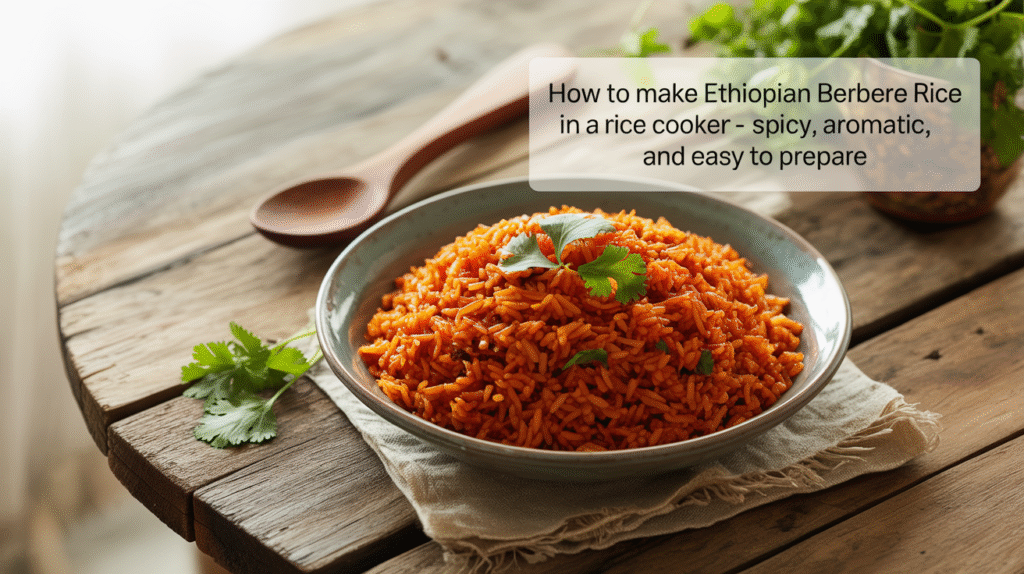Yes, you can enjoy the deep, earthy heat of Ethiopian cuisine in a simple rice cooker dish. By incorporating berbere spice, a fiery and fragrant East African blend, into your rice along with hearty vegetables and legumes, you get a one-pot meal that’s bold, satisfying, and effortless to prepare.

This guide will show you how to make Ethiopian Berbere Rice in your rice cooker using pantry staples and a burst of spices that bring the Horn of Africa to your kitchen.
What Is Ethiopian Berbere Rice?
Berbere is a complex Ethiopian spice mix that usually includes chili powder, garlic, ginger, fenugreek, cardamom, and other warm spices. Ethiopian Berbere Rice is a fusion-style dish that uses this mix to transform plain rice into a flavorful main or side dish, often enriched with lentils or chickpeas for protein.
Why Make It in a Rice Cooker?
Cooking Berbere rice in a rice cooker is not only time-saving but also results in even flavor infusion without constant stirring.
- Simplifies the traditional layering and simmering process.
- Locks in moisture, spice, and fragrance.
- Ideal for batch cooking or easy meal prep.
Ingredients for Ethiopian Berbere Rice
You don’t need rare ingredients to enjoy this East African favorite at home. Here’s what you’ll need:
- 1½ cups basmati or jasmine rice, rinsed and soaked
- 1¾ cups water or vegetable broth
- 1 tbsp olive oil or niter kibbeh (spiced butter)
- 1 small onion, diced
- 1 clove garlic, minced
- 1½ tsp berbere spice mix (adjust to taste)
- ½ tsp ground cumin
- ½ cup diced tomatoes (canned or fresh)
- ½ cup cooked lentils or chickpeas
- 1 small carrot, chopped
- ¼ cup green peas (optional)
- Salt, to taste
- Lemon juice and chopped parsley, for garnish
Step-by-Step Instructions
Cooking Ethiopian Berbere Rice in a rice cooker is a streamlined process that maximizes flavor without extra pans.
Step 1: Prepare Base Flavors
- If your rice cooker has a sauté or “cook” mode, lightly sauté onions in olive oil until golden.
- Add minced garlic and stir for 30 seconds.
- Mix in berbere spice and cumin and let bloom for 30–60 seconds.
- If your cooker does not support sautéing, do this step separately on the stovetop.
Step 2: Combine and Layer Ingredients
- Add rice, diced tomatoes, carrots, peas, lentils or chickpeas, and salt.
- Pour in water or broth and stir gently to mix.
- Avoid over-stirring to preserve texture.
Step 3: Cook and Steam
- Start the rice cooker using the white rice or standard setting.
- Once complete, allow the rice to rest with the lid closed for an additional 5–10 minutes to finish steaming.
Step 4: Finish and Serve
- Fluff gently with a fork.
- Squeeze in lemon juice and top with chopped parsley or cilantro.
Tips for Better Flavor
Small additions and substitutions can enhance the dish:
- Add richness with a spoonful of ghee or niter kibbeh stirred in at the end.
- Include whole spices like a cinnamon stick or bay leaf during cooking for extra aroma.
- Make it saucier by stirring in a tablespoon of tomato paste before cooking.
Variations and Substitutes
This dish is highly adaptable and works well with several changes.
- Grain-free option: Substitute rice with cauliflower rice (adjust cooking time accordingly).
- Milder version: Reduce berbere to ½ tsp and add a touch of honey for balance.
- Protein boost: Add grilled tofu or seared tempeh for a more complete meal.
Serving Suggestions
Ethiopian Berbere Rice pairs beautifully with other East African dishes or can stand alone.
- Serve alongside collard greens (gomen) or stewed lentils (misir wot).
- Pair with a cucumber-tomato salad to cool the heat.
- Add flatbread like injera or pita for a more traditional touch.
Storage and Reheating
This rice dish keeps well and can be used in multiple ways:
- Store in airtight containers for up to 3 days in the refrigerator.
- Reheat with a splash of broth or water in a covered pan or microwave.
- Freeze for up to 1 month, perfect for busy days.
FAQs About Ethiopian Berbere Rice in a Rice Cooker
Here are some questions and answers about making Ethiopian Berbere Rice in a rice cooker.
What is berbere spice made of?
Berbere typically includes dried chili peppers, garlic, ginger, basil, korarima, rue, ajwain, nigella, and fenugreek, though the mix can vary by region or brand.
Is Berbere Rice supposed to be spicy?
Yes, berbere has a spicy, warming kick, but you can control the heat by using less spice or adding coconut milk to mellow the flavor.
Can I make it without legumes?
Absolutely. Lentils or chickpeas add protein, but the dish works with just vegetables and rice.
Can I make my own berbere spice mix?
Yes. Mix chili powder, paprika, cumin, cinnamon, ginger, cardamom, coriander, cloves, nutmeg, and salt in proportions to your taste.
Does it taste like Indian or Middle Eastern rice?
Not exactly. While it shares warm spice notes with Indian and Middle Eastern cuisines, berbere has a unique earthy heat and herbal undertone that sets it apart.
Ethiopian Berbere Rice in a rice cooker is a perfect way to enjoy the exotic, bold flavors of Ethiopia with modern convenience. Whether you’re new to African cuisine or a spice lover looking to try something different, this one-pot dish delivers warmth, nutrition, and unforgettable taste.